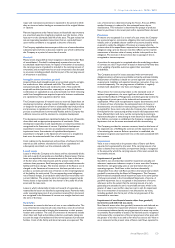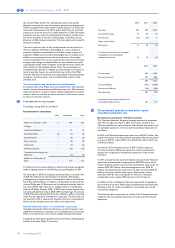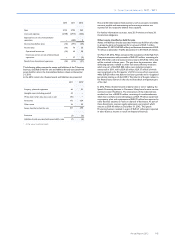Philips 2012 Annual Report Download - page 138
Download and view the complete annual report
Please find page 138 of the 2012 Philips annual report below. You can navigate through the pages in the report by either clicking on the pages listed below, or by using the keyword search tool below to find specific information within the annual report.
12 Group financial statements 12.10 - 12.10
138 Annual Report 2012
Investing category. In the consolidated statements of cash flows,
prior years have been adjusted as shown in the table below to reflect
appropriate presentation:
2010 2011
Statements of cash flows
Operating: Depreciation and amortization (14) (2)
Operating: Other items 14 2
Operating: Decrease (increase) in inventories (47) (68)
Investing: Capital expenditures on property,
plant and equipment 49 71
Financing: Proceeds from issuance of long-
term debts (2) (3)
IFRS accounting standards adopted as from 2013 and onwards
The following standards and amendments to existing standards have
been published and are mandatory for the Company beginning on or
after January 1, 2013 or later periods, and the Company has not yet
early adopted them.
IAS 1 Presentation of financial statements (2011 amendment)
The new amendment requires separation of items presented in other
comprehensive income into two groups, based on whether or not they
can be recycled into the Statement of income in the future. Items that
will not be recycled in the future are presented separately from items
that may be recycled in the future. The amendment will be adopted on
January 1, 2013 and will be applied retrospectively. The amendment
was endorsed by the EU. The application of this amendment impacts
presentation and disclosures only.
IAS 19 Employee benefits
The revisions to IAS 19 are effective for annual periods beginning on
or after January 1, 2013, and have been endorsed by the EU. In general,
the amendment no longer allows for deferral of actuarial gains and
losses or cost of plan changes and it introduces significant changes to
the recognition and measurement of defined-benefit pension expenses
and their presentation in the Statement of income. Additional
disclosure requirements have been added for risks and plan objectives
and the distinction between short-term and other long-term benefits
has been revised. The revisions further clarify the classification of
various costs involved in benefit plans like expenses and taxes.
The amendment will have a material impact on income from operations
and net income of the Company, resulting from the changes in
measurement and reporting of expected returns on plan assets (and
interest costs), which is currently reported under income from
operations. The revised standard requires interest income or expense
to be calculated on the net balance recognized, with the rate used to
discount the defined-benefit obligations.
There is no impact on the cash flow statement and the balance sheet,
since the Company already applies immediate recognition of actuarial
gains and losses in other comprehensive income. The Company also
has some unrecognized past-service cost gains and losses which must
be recognized. The net impact lowers our balance sheet liabilities with
EUR 10 million.
The new standard no longer allows for accrual of future pension
administration costs as part of the DBO. Such costs should be expensed
as incurred. Under the current standard, the Company in the Dutch
plan includes a surcharge for pension administration costs as part of the
service costs into the DBO. With the adoption of the new standard
this accrual needs to be eliminated resulting in an exclusion of EUR 200
million from the DBO, thereby improving the funded status. This
funded status improvement is offset by the impact of the asset ceiling
test regarding the Dutch plan’s surplus, and hence there is no further
impact on the Company’s balance sheet figures.
The expected negative impact of IAS 19 Revised for post employment
defined-benefit plans on Income from Operations and Income before
tax for 2013 (as compared to current IAS 19) is:
Income from operations EUR (280) million
Financial income and expenses EUR (75) million
Income before taxes EUR (355) million
As from January 1, 2013 the Company will present net interest expense
as part of Financial income and expenses. Comparative figures will be
restated accordingly.
The standard also enhances the definition of termination benefits and
what constitutes a benefit for future service. In many cases these
clarifications are reinforcing the current guidance; therefore this is not
expected to materially impact the Consolidated financial statements.
IFRS 9 Financial Instruments
The standard introduces certain new requirements for classifying and
measuring financial assets and liabilities. IFRS 9 divides all financial assets
that are currently in the scope of IAS 39 into two classifications, those
measured at amortized cost and those measured at fair value. The
standard along with proposed expansion of IFRS 9 for classifying and
measuring financial liabilities, derecognition of financial instruments,
impairment, and hedge accounting will be applicable from January 1,
2015, although entities are permitted to adopt earlier. This standard
has not yet been endorsed by the EU. The new standard will primarily
impact the accounting for the available-for-sale securities within Philips
and will, accordingly, change the timing and placement (profit or loss
versus other comprehensive income) of changes in the respective fair
value. The actual impact in the year it is applied cannot be estimated
on a reasonable basis.
IFRS 10 Consolidated Financial Statements, IFRS 11 Joint
Arrangements and IFRS 12 Disclosure of Interests in Other
Entities (2011)
IFRS 10 introduces a single control model to determine whether an
investee should be consolidated. The new standard includes guidance
on control with less than half of the voting rights (‘de facto’ control),
participating and protective voting rights and agent/principal
relationships. The Company does not expect that the adoption will have
a significant impact on the Company’s Consolidated financial
statements.
Under IFRS 11, the structure of the joint arrangement, although still an
important consideration, is no longer the main factor in determining
the type of joint arrangement and therefore the subsequent accounting.
Instead:
• The Company’s interest in a joint operation, which is an arrangement
in which the parties have rights to the assets and obligations for the
liabilities, will be accounted for on the basis of the Company’s
interest in those assets and liabilities.
• The Company’s interest in a joint venture, which is an arrangement
in which the parties have rights to the net assets, will be equity-
accounted.
The currently applied accounting policy by the Company already means
that jointly controlled entities are being accounted for using the equity
method. The adoption therefore does not have a material impact on
the Company’s Consolidated financial statements.
IFRS 12 brings together into a single standard all the disclosure
requirements about an entity’s interests in subsidiaries, joint
arrangements, associates and unconsolidated structured entities. IFRS
12 requires the disclosure of information about the nature, risks and
financial effects of these interests. The Company is currently assessing
the disclosure requirements for interests in subsidiaries, interests in
joint arrangements and associates and unconsolidated structured
entities in comparison with the existing disclosures.
These standards are effective for annual periods beginning on or after
January 1, 2013 with early adoption permitted.
























